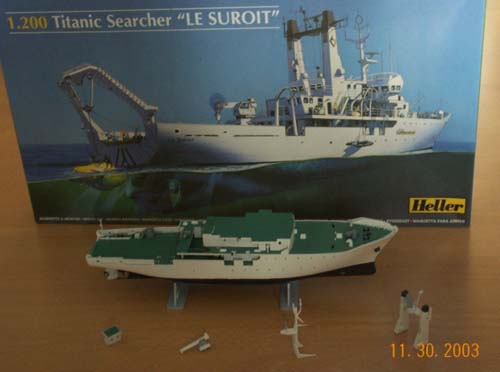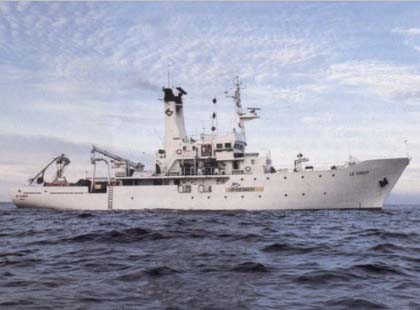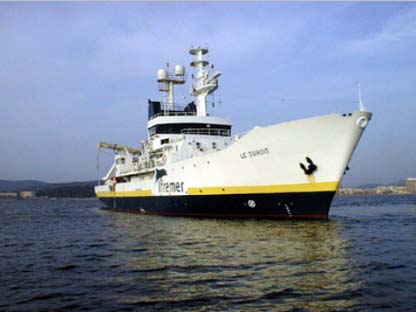
Heller's 1:200 scale Le Suroit

Olaf’s model under construction – without bridge-house
If the discovery of Titanic’s wreck in 1985 or Cameron’s movie from 1997 and the hype swapping around the world was the reason to release this kit is unclear. I have no idea when this kit was first released and I’ve never noticed it until 2002 x-mas as it was lying under the tree. I assume that the molds for this kit aren’t very old because there is only little flash visible. The kit fits perfectly to Heller´s same scaled Smit Rotterdam – another one of the few merchant kits available. (Not to forget their Avenir !) Although the Le Suroit is a bit smaller the attentive reader will be pleased to hear that it is sharing Heller´s fine quality standards. The ship in 1:200 is good for 11.09" in length and 2.17" in width for the hull which is a three piece assembly (port/stb/sternplate). The overall height should be around 4.5" – after my dry-fitting and without display stands. All in all the kit contains 101 parts in six (incl. one for railings and one for clear parts) bagged frames molded in light grey – my kit surprised me with eight frames! Two different were put in twice – thanks to Heller for a lot of spare parts! The part´s connection to the frames could have been a bit thinner – I recommend not cutting off the parts directly on its edge – this may cause some damage to it.
Assembly instructions: What a fine instruction! Everything is printed in a large format and very eye-friendly – nearly every detail is visible making the part´s reference number unnecessary (LOL). Paint instruction are easy to follow but should be compared with original photos if no Heller paints or paint charts are available. Rigging is not illustrated which requires some extra research. The decal sheet includes a brick red boot topping which isn’t visible on earlier original photos. This wasted space on the sheet should have been filled with decals of registration flags and draught markings.
Hull: all of the three pieces fit perfectly together – filling and sanding the seams was no problem. A bit tricky was to fill and sand the bow seam which is running across the bow’s hawsehole. I recommend painting the hull after filling and sanding the f’c’sle bulwark to the hull. Perhaps the advanced modeller would remove the bulwark from the deck because the hull’s bulwark is doing the same job very well – only the supporting stanchions have to be scratchbuilt later. A paint line dividing the upper from the lower hull is clearly marked. For the location of the display stands the hull’s bottom figures two pair of fine lines which aren’t really necessary. Portholes are already drilled out which can be backed with acetate. Comparing the hull’s kit with photos of the actual ship some inaccuracies in the porthole configuration become noticeable: The whole upper stb row should have been located a bit more forward. It’s of the modeller’s choice to alter this – we’re talking about less than 2mm. The port side portholes are more or less correct in their configuration. The number of portholes is correct on both sides but the fwd of the long and thin openings (to allow water to poor back outboards) on the aft port side at spar deck level is much to short. Heller has mirrored the stb side on which this opening is limited by the aft bulwark opening. The different sizes of the hawseholes are represented correct. An old b/w photo of the stern plate shows some diagonal black painted frames which are molded on the kit. On later pics six of them – the three outer ones on each port and stb side aren’t visible anymore (or painted white…like on the box illustration). The middle (vertical) frame is missing on the kit – easy to fix with styrene. A bow thruster is molded into the hull but it is unclear if this was a later addition to the ship or not. Pictures taken before the redesign do not show the marking above the waterline which is common to ships equipped with bow thrusters. Please compare the pics (1985 and today)…
Superstructure and decks: Parts fit perfectly together and all bulkhead windows are molded open and could be backed with acetate like the hull portholes. Window covers on the fwd superstructure, rain cutters, hinged doors, stairways, venting ribs, ladders are indicated as fine as the coverings of some deck service-openings. On the one hand inflatable life-rafts, the small (Zodiac?) boat, bits and hatches are molded onto the deck while on the other hand several parts like stairs, winches, vents, cranes and other items have to be glued separately. Curiously, there are no anchor chains provided – perhaps the distance from the deck opening to the anchor-winch is too short or it was too difficult to produce. This can be easily fixed with some short metal chains. The two inflatable life-rafts on the deck in front of the bridge are missing, too. Most of the deck fittings which are necessary for a research vessel are fine detailed – the advanced modeller will probably do some super detailing – after spending hours on research because detailed pictures of the actual vessel are hardly to find – except those which are showing it’s today’s appearance. Mast- , navigating radar- and the four funnels-parts are well detailed but – and this is a big BUT: the two funnels are molded out of two halves each - which means that the seams are running directly across the funnels venting ribs – nearly impossible to fill and sand without destroying those fine looking ribs… another flaw is part #6 (stb bridge bulkhead) which is molded inside out… The provided railings are a bit to thick but their height seems to be correct. The small submersible (named Cyana) sitting on the aft deck is a really cute eye-catcher and makes clear the purpose of the big portal-like crane on the aft end of the deck. I highly recommend to paint the walls after gluing them together, because the vertical seams on most of the corners should be filled and sanded.

Le Suroit in 1985
Nowadays appearance: the kit represents the lines and colours which we know from the pictures of the discovery of the Titanic. The assembly instruction depicts the ship in its 1985 appearance. With her white hull, black a/f-paint and the green deck she isn’t as colourful as the Smit Rotterdam but still nice. Today the ship wears a more dramatic coat: The lower part of the upper hull is painted dark blue which is divided from the white by a yellow stripe on level of the lower row of portholes. The a/f-paint has changed from black to red and the Ifremer - logo was enlarged. The fwd stb porthole of the upper row is now missing. The funnels aren’t as tall as the old ones and they are of a rectangular design with dark blue funnel tops - the platform between them was replaced by a new one (a bit lower than the old one) carrying a mast with new Satcom- or Inmarsat –equipment. The mast on the bridge roof was modernized and redesigned and the roof is surrounded by a new shaped bulwark. The bridge superstructure has received a dark blue band at window level. The deck colour has changed from green to grey (?) - hardly to see in pictures. Perhaps these are only a few alterations which were given to the ship’s appearance I have identified up to now (with only a few pictures) - but with them and with looking at better photos the kit could be converted to this new and refreshing design.

Le Suroit today
Overall Rating: Heller produces a very fine kit which is worth the money and it should be considered by the merchant ship enthusiasts who wants to built "something different". Some areas of the ship are asymmetrical (like the bridge superstructure) which makes her a very interesting looking ship. There are only a few merchant ship kits on the market and perhaps this one and Revell’s Meteor (1/300 – grmblgrmbl!!) are the only Research Vessel kits available – (can anyone confirm this?) Building the model straight out of the box creates a high detailed and accurate ship. Windows and portholes should be backed with acetate as mentioned above. Surfing the web I’ve seen a motorized and illuminated 1/200 model – seems to be that everything is possible! Although that there are a few inaccuracies (which aren’t impossible to fix) this kit is very impressive – due to its scale, quality, accuracy and its fine assembly instruction I feel free rating it with 8 out of 10.
Olaf Schulze, 12/03